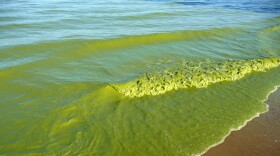The toxic cyanobacterial bloom that’s become a yearly problem in Lake Erie’s western basin was relatively small this year.
But the bloom has lasted an unusually long time. Usually, it starts to clear up toward the end of the summer. But this year, the bloom was still there well into the fall.
Tom Zimnicki is with the Alliance for the Great Lakes. He attributed that to the unusually warm fall weather we’ve had. “Last week there was still a bloom that was over 250 square miles in the basin, and so sticking around for a lot longer,” he said.
Zimnicki said the bloom did start to dissipate in early November, with increased water churn in the lake. But he said its duration is still notable. “[It’s] important to note just how long the bloom has stuck around this year, I think largely due to just such a warm fall that we've been having,” he said.
Zimnicki said that with growing impacts from climate change, we’re likely to see blooms last longer in the future. He added that that even when toxic cyanobacterial blooms are relatively small, they still have big effects, impacting recreational lake activities and drinking water quality, among other things.
Lake Erie’s cyanobacterial blooms are largely caused by excess agricultural chemicals, especially phosphorus runoff from fertilizers, washing into the lake.












